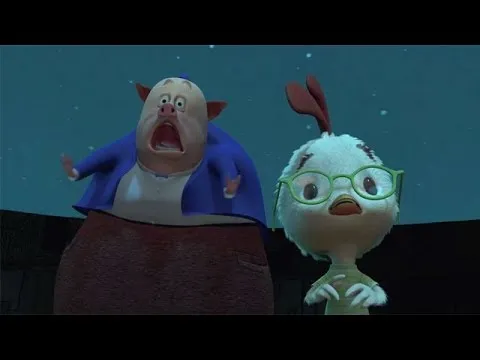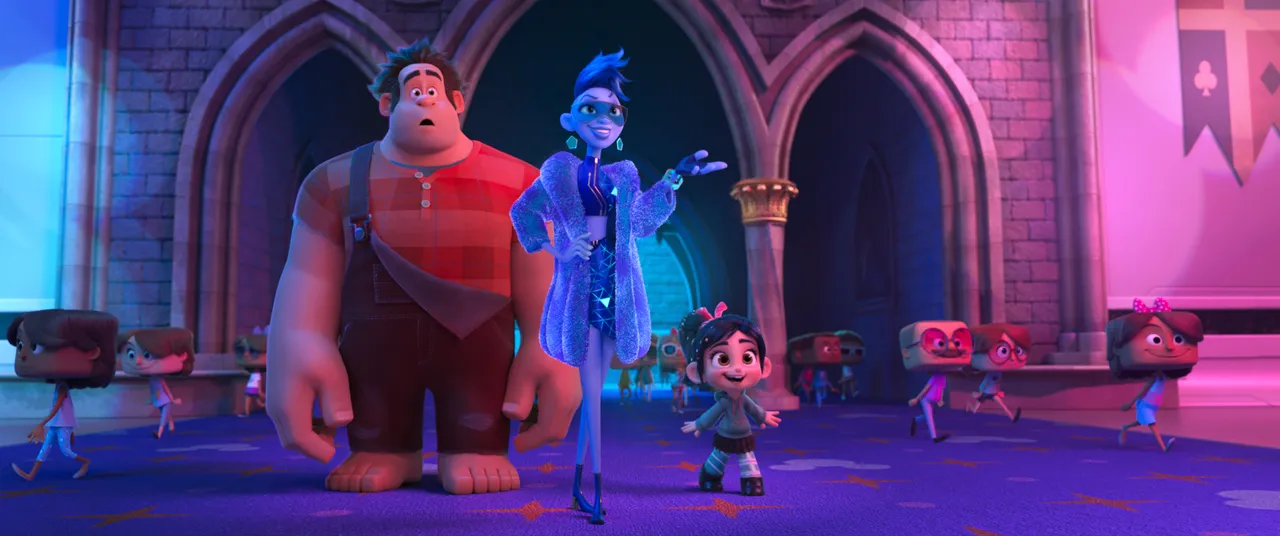
Oh, look, mom, PewDiePie’s last YouTube vid… okno | Source: The Verge

Gone are the days when Pixar was master and commander of 3D animated films. For better or worse, at least fifteen studios, just by following their footsteps, have begun to leave their mark and to question their hegemony in a terrain more competitive than ever. For much of the 2000s and early 2010s, Pixar saw DreamWorks Animation, Sony Pictures Animation, 20th Century Fox Animation, and Nickelodeon Movies becoming worthy contenders for their pedestal on more than one occasion.
As CGI quality began to soar in the 2010s, so did the emergence of new players in the scene. Illumination Entertainment, Aardman Animation, Laika and Blue Sky Studios, among others, ended up forming, side-by-side with the former studios, an enormous offer that now makes the industry feel almost saturated, were it not for the freshness and good reception of their proposals.
Yet...
...where was Disney?
Although the easy answer to this question would be "buying everything like the capitalist behemoth it is", the truth is that Disney was studying the market and making a considerable effort to learn behind the scenes. You could tell that, in the end, purchasing Pixar in 2006 for $7.4 billion got them a lot more than what they bargained for. By employing the ineffable - and sadly fallen from grace, as I write this article - John Lasseter and getting him to work closely with Edwin Catmull as Pixar’s CEO, Disney brought new life to what used to be the best animation studio in the world.
To think that, back in 2005, this was Disney’s strongest offering in CGI… 🙄 | Source: Movies-List @YouTube
In 2007, John Lasseter renamed Walt Disney Feature Animation as Walt Disney Animation Studio. The changes went far beyond nomenclature: Lasseter also brought Pixar's film production model to Disney, with their particular stamp on storytelling and its focus on authors above studio guidelines. A large number of executives and intermediaries were fired or sent to other Disney divisions, and Lasseter began to meet personally and regularly with most of Disney’s animation directors. This strategy slowly established a close association of creative minds right at the top of the studio, the Disney Story Trust, which was by definition very similar to Pixar's own Braintrust.
The result of these changes?
A string of successful films that would put Disney back on track.
With the good reception of productions like Bolt (2008), The Princess and the Frog (2009) and Tangled (2010), Disney steadily recovered a part of their old glory. Bolt and Tangled in particular allowed John Lasseter to take an idea that, surprisingly, was being considered by the studio since twenty years ago, having first been born in the late 80s with a quite singular name: High Score.
Although this idea went through at least three revisions before reaching its final version, the concept always had to do with a video game character, bored of repeatedly doing the same thing. The idea had always been in the hands of Rich Moore, animation director, and scriptwriter at Disney, but none of the versions had convinced him enough to bring it into production. In the end, the fourth time was the charm, with a particular twist: the character in question was the video game’s villain, tired of being thrown aside in the interest of celebrating the hero's successes.
Thus, the premise of Wreck-It Ralph was born.
As unbelievable as it might sound, Wreck-it Ralph’s initial trailer reception was lukewarm at best | Source: Walt Disney Animation Studios @YouTube
In a considerable change of roles over a story that reminded many people of Donkey Kong’s (1981) arcade version, the main character was not Fix-It Felix, Jr., the Niceland Bldg.’s maintenance man and the player’s avatar in the eponymous video game, but Wreck-It Ralph, its hated, lonely antagonist. While participating in a villain support group, in which Ralph coincides with many other evildoers, he concludes that he no longer wants to be a mean man, now coveting both the medal and hero status given by the Niceland Bldg.’s tenants to his rival.
The result of this plot was a surprise hit for Disney, which raised $471.2 million worldwide. Hugely motivated by a wave of nostalgia for the 8-bit era of video games and with a cast that any gamer could identify with, Wreck-It Ralph was unanimously approved by critics and audiences and earned a renewed respect for the studio that would only be surpassed, at least for the time being, by Frozen (2013).
The question, for many, was not whether Disney would eventually release a sequel to Wreck-It Ralph...
...but when they would do it. Although Rich Moore had already commented to the press and fans several times on the subject, warning that he had barely scraped the surface of both the ideas and universe they had built at Wreck-It Ralph, official confirmation just came in March 2016, with a tentative release date of 2018.
Finally, in November 2018, Ralph Breaks the Internet made its appearance in cinemas around the world...
... and, although it may not fully capture the magic of its predecessor, it manages to be a real surprise and a thoughtful improvement.
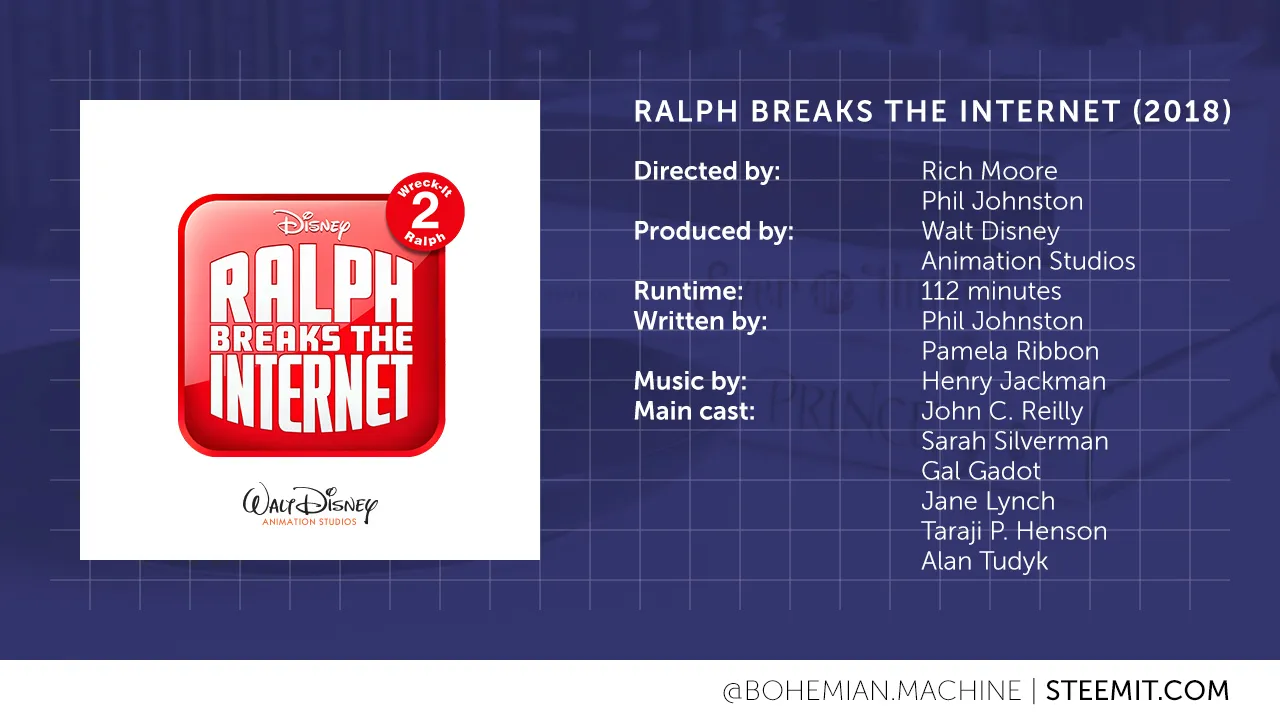

The premise of Ralph Breaks the Internet, as in any good animated film, is simple. Following Wreck-it Ralph’s ending, we see how Ralph is now not only a much more respected and welcomed character in Mr. Litwak's arcade but how he has established a close friendship with Vanellope. Although he still attends the same villain support group he attended in the first film, Ralph is a changed and fulfilled man who could not be happier with both his accomplishments and his best friend.
However, the situation for Vanellope is quite different. Bored of how monotonous existence has become in her own game, Sugar Rush, Vanellope longs for a change. After confessing this to Ralph, he decides to alter Sugar Rush’s racetrack to surprise her. Although the big-hearted man’s intention proves to be correct, his plan's execution ends disastrously; the clients who played in the Sugar Rush machine, trying to control a Vanellope that was moving independently, destroy the game's steering wheel.
The girls complain to Mr. Litwak, incapable of understanding why Sugar Rush glitched like that. The arcade’s owner confesses a more complex reality to them: the arcade they ruined was discontinued years ago, and getting any spare part for it is an almost impossible task. Trying to make amends for their mistake, the girls use their smartphones and look for a replacement on eBay. Priced at $2,000, Mr. Litwak does nothing to hide his shock. The monthly income that Sugar Rush makes is not enough to repair the machine.
In Mr. Litwak's mind, there is only one option.
To turn off Sugar Rush and store it in the warehouse.
Naturally, this is not an option for Ralph, and solving his best friend's predicament will lead him to do whatever it takes to buy that steering wheel and rescue Sugar Rush from oblivion. It will take him, again, to enter a completely different world than the one he used to be and to take on a series of challenges in order to be Vanellope's hero again...
...or maybe not?
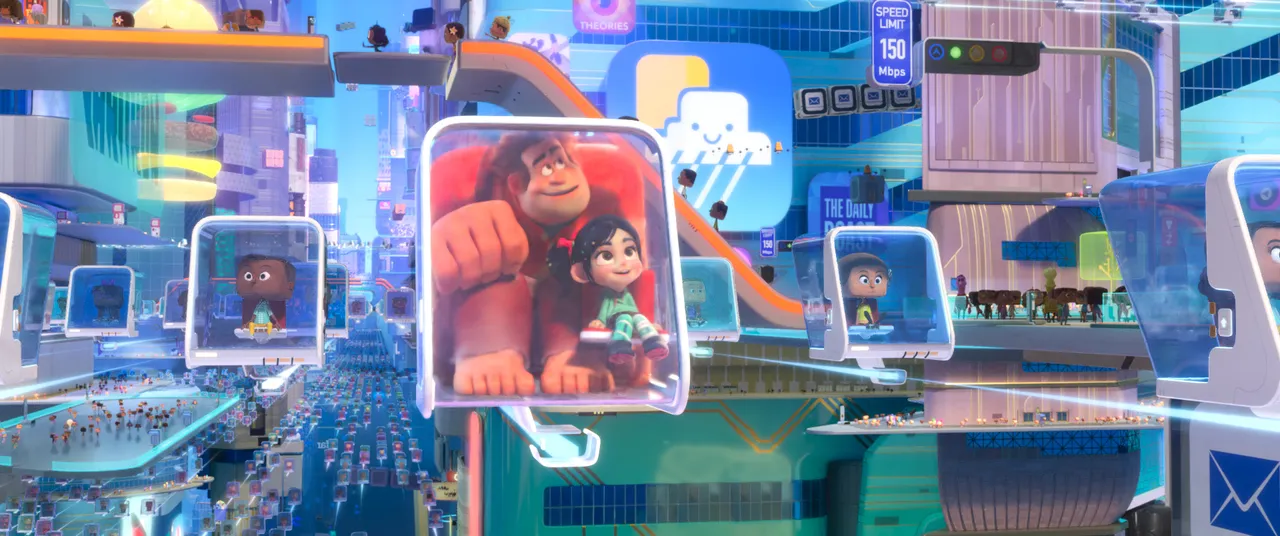
Ralph Breaks the Internet really takes these pair’s story to unexpected… and tight directions | Source: The Verge
As it was already glimpsed in his first trailer, Ralph Breaks the Internet would leave the relative security of Mr. Litwak's arcade to expose himself to a much larger and more complex world; the Internet. Not that this trailer was free from any suspicion; many people thought, justifiably and in light of recent releases such as The Emoji Movie (2017), that Disney would put one of their most respected IPs of recent years at the service of their own marketing machinery, risking to completely derail the franchise in the process.
Nevertheless, Ralph Breaks the Internet’s plot manages to find a treatment that, although is not exactly something we have never seen in Disney movies, is still very unusual and mature for what in comparison to what they usually do. Because, yes, all Disney movies, to a greater or lesser extent, talk about friendship. However, Ralph Breaks the Internet does it from such a crude perspective that sometimes it seems to border on the pessimistic by asking some very tough questions: how far are you able to go to keep a friendship? Can commitment be fully disinterested? To what extent? What part of the happiness you expect for someone is what she expects and what part of it is what you expect?
By the time the movie has managed to answer all of these questions, you will most likely believe that you walked in the theater to watch Ralph Breaks the Internet and walked out of the theater watching Ralph Breaks your Heart in Infinite Pieces...
...and that, hard as it may seem to believe, is fine. REALLY fine.
At a time when anti-values seem to have become fashionable in human relationships – try reading some young adult and erotic novels of our time, for instance (?) - it is refreshing that Disney takes a step forward in discussing said values, especially when they were culprits in bringing a lot of said distortions decades ago. However, this creates a somewhat strong dissonance considering that the film was theoretically not about toxicity, vanity, and bad decisions, but about the Internet...
... and, unfortunately, Ralph Breaks the Internet does not fare very well when it comes to actually break the Internet.
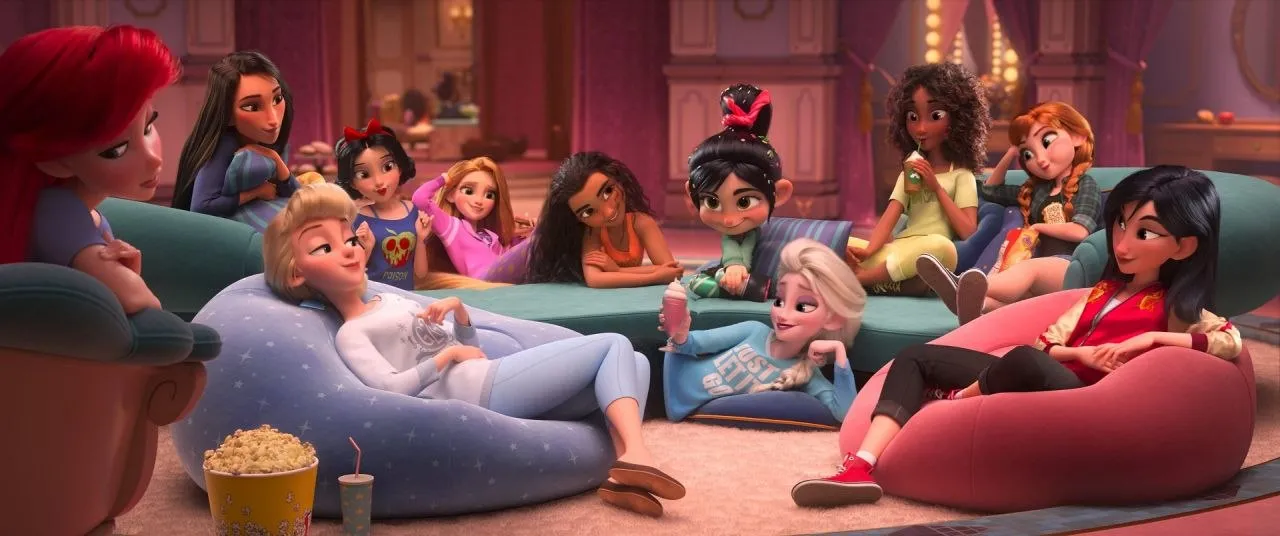
Even though this scene is preceded by some blatant, in-your-face marketing from Disney… It still manages to be one of the movie’s best and funniest scenes by far | Source: Polygon
Although most of the jokes about millennials’ preferred vice the World Wide Web are funny, they only work at a basic level. Probably because of the weight of being a family movie at its heart, Ralph Breaks the Internet does not allow itself to be acidic enough about issues that besiege the Internet community as we speak – Twitter’s nauseating toxicity, the net becoming social justice warriors and trolls’ main battleground, sensitive information leaking, to number a few. The result is a decaffeinated, rather hopeful version of what we are actually facing right now as Internet users.
Where Ralph Breaks the Internet largely succeeds, however...
... is in mocking, openly and sincerely, Disney’s own legacy.
One can only wonder how the film's production team could have gotten away with so many self-referential jokes.
Yes, it is true: there is a considerable amount of Disney marketing in the film’s second act.
Yes, it is true: Disney wants to conquer the world with its digital streaming service and the film devotes a fortunately short part of its footage to show us how wonderful it would be to have all of Disney's content in one place.
Yes, this five-minute ad precedes to what is maybe the film’s best scene by a landslide.
Being a particular hallmark, not only of Disney as a company but of their enormous power in the girl’s toys and products industry, the Princesses are one of the most difficult-to-evaluate institutions Disney has ever built. On one hand, it is true that the ability of the aforementioned brand’s power to invoke nostalgia and tenderness is indisputable, especially when women have always played a relevant role in Disney films, but on the other...
... it is well known that the relevance of such a role is due to rather backward reasons.
It is therefore refreshing to watch how Disney - or at least a small fraction of it - decides to step forward and introduce us to the Princesses behind the scenes, secretly fed up with what is expected of them and allowing themselves a moment to be just girls. Although this scene lasts less than we would have liked, not only is it fundamental to advance Vanellope's plot, but it will delight everyone who hoped that, at least once in a lifetime, Disney would accept that they are behind all our unrealistic, contemporary expectations about love should urgently revise their female characters’ concept and legacy.
Most of all because, surprisingly, Ralph Breaks the Internet's females carry a lot of weight on its plot.

Changing her role from rival to teacher, Shank catalyzes Vanellope’s change from a quite unidimensional character to a nuanced, empathy-worthy one | Source: Código Espagueti
There are moments when it is not clear if Ralph really is the protagonist of this film; for a good part of the second act, the film centers on developing a Vanellope who does not want to continue playing a role that bores her and minimizes her. The emergence of a new character, Shank - the protagonist and heroine of Slaughter Race, Grand Theft Auto and Carmageddon’s bastard son - inspires Vanellope to find her true dream in a way that is not only hilarious, but puts her in a difficult position with Ralph - remember the "toxic friendships" thing? – and sets the chaotic, transforming third act in motion.
During their trip, Ralph and Vanellope also run into Yesss, BuzzTube’s - again, I see what you did there, Disney – young, trendy creative marketing director who offers to help them in their search using the extensive resources of her streaming platform. This character is not only a funny allusion to how watching people becoming famous on the Internet by questionable methods fascinate us but also an effective representation of an incredibly self-confident, cunning and helpful woman. In the 21st century, even Disney's fairy godmothers had to update themselves a bit.

Little can be said about Ralph Breaks the Internet’s acting and production that is anything other than outstanding. The quality of the CGI and art direction of Disney's 3D movies has greatly improved because of their cultural exchange with Pixar and this clearly shows in how vivid and colorful their Internet’s digital interpretation turns out in the movie. However, some metaphors and decisions in the conceptualization of this world are as simple and vapid as the plot gets when touching certain internal aspects of the World Wide Web.
Ralph Breaks the Internet's voice acting is as phenomenal as you would expect, with John C. Reilly and Sarah Silverman effortlessly voicing Ralph and Vanellope and giving their best to turn them into three-dimensional, caring characters. Gal Gadot does an effective – if slightly anecdotic of her role as Wonder Woman – part as Shank, Slaughter House’ resourceful and inspiring boss character, while Alan Tudyk and Alfred Molina get funny-as-hell parts as Knowsmore, a corny-but-loveable Google parody, and Double Dan, a virus creator who inhabits the Deep Web. As a particular note, most of the original Princesses’ traditional actors return to make their voices in this film, accentuating the nostalgic and ironic power of the scenes they are involved with.
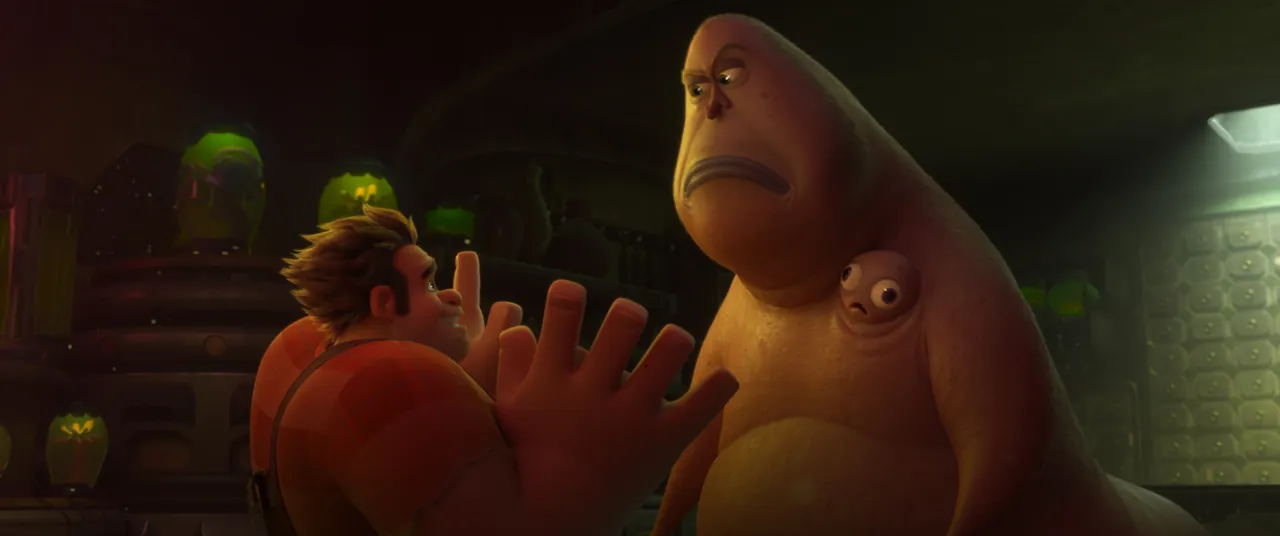
That's just... gross, man | Source: Polygon
Is Ralph Breaks the Internet an ideal film to laugh at the current state of the Internet and our society? Yes and no. Although some jokes are quite funny, the truth is that Disney could have done much better research work and produce a more contemporary plot that handled the harsh state of what could be our last bastion of freedom and knowledge. Where this film does dare to break paradigms and go a step further, though, is in our perception of what Disney was and is. With a renewed, daring approach when it comes to readjusting its legacy and dealing with emotionally sensitive issues, for the time being...
... we can give them the benefit of doubt.
Thank you for reading my post!
I try to answer as many comments as possible, so, feel free to leave yours in the comment section! 👇
100% original content made by yours truly,

